Discover 35 hidden attractions, cool sights, and unusual things to do in Toronto (Canada). Don't miss out on these must-see attractions: Art Gallery of Ontario, CN Tower, and Harbourfront Centre. Also, be sure to include Royal Ontario Museum in your itinerary.
Below, you can find the list of the most amazing places you should visit in Toronto (Ontario).
Table of Contents
Art Gallery of Ontario
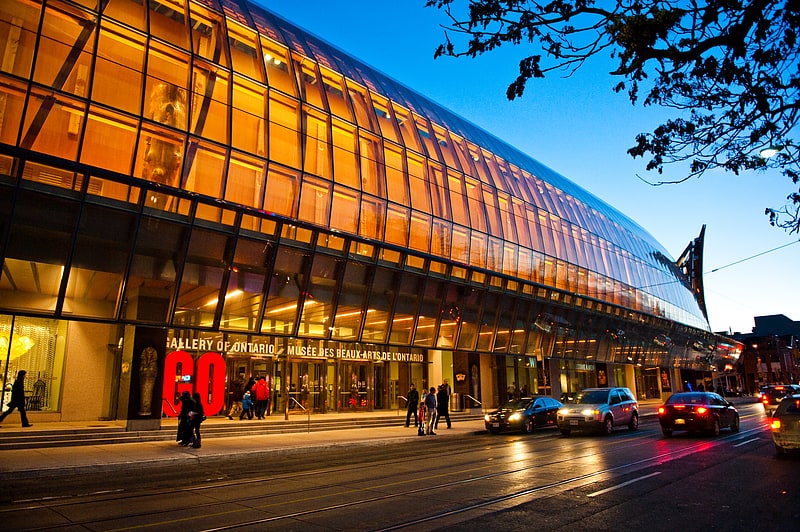
Famous Canadian art and Gehry renovation. The Art Gallery of Ontario is an art museum in Toronto, Ontario, Canada. The museum is located in the Grange Park neighbourhood of downtown Toronto, on Dundas Street West between McCaul and Beverley streets just east of Chinatown. The museum's building complex takes up 45,000 square metres of physical space, making it one of the largest art museums in North America and the second-largest art museum in Toronto after the Royal Ontario Museum. In addition to exhibition spaces, the museum also houses an artist-in-residence office and studio, dining facilities, event spaces, gift shop, library and archives, theatre and lecture hall, research centre, and a workshop.
Established in 1900 as the Art Museum of Toronto, and formally incorporated in 1903, it was renamed the Art Gallery of Toronto in 1919, before it adopted its present name, the Art Gallery of Ontario, in 1966. The museum acquired the Grange in 1911 and later undertook several expansions to the north and west of the structure. The first series of expansions occurred in 1918, 1924, and 1935, designed by Darling and Pearson. Since 1974, the gallery has undergone four major expansions and renovations. These expansions occurred in 1974 and 1977 by John C. Parkin, and 1993 by Barton Myers and KPMB Architects. From 2004 to 2008, the museum underwent another expansion by Frank Gehry. The museum complex saw further renovations in the 2010s by KPMB and Hariri Pontarini Architects.
The museum's permanent collection includes over 120,000 works spanning the first century to the present day. The museum collection includes a number works from Canadian, First Nations, Inuit, African, European, and Oceanic artists. In addition to exhibits for its collection, the museum has organized and hosted a number of travelling art exhibitions.[1]
Address: 317 Dundas St W, M5T 1G4 Toronto (Downtown Toronto)
CN Tower
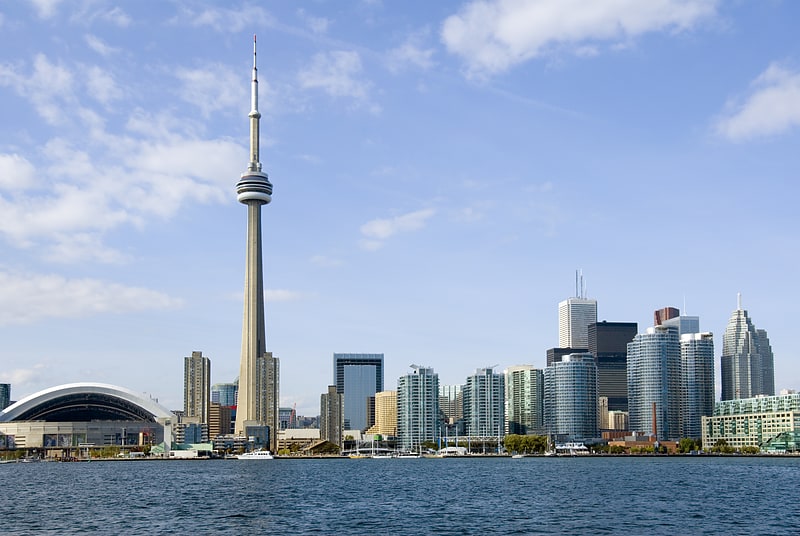
Iconic tower with a revolving restaurant. The CN Tower is a 553.3 m-high concrete communications and observation tower in downtown Toronto, Ontario, Canada. Built on the former Railway Lands, it was completed in 1976. Its name "CN" referred to Canadian National, the railway company that built the tower. Following the railway's decision to divest non-core freight railway assets prior to the company's privatization in 1995, it transferred the tower to the Canada Lands Company, a federal Crown corporation responsible for real estate development.
The CN Tower held the record for the world's tallest free-standing structure for 32 years, from 1975 until 2007, when it was surpassed by the Burj Khalifa, and was the world's tallest tower until 2009 when it was surpassed by the Canton Tower. It is currently the ninth-tallest free-standing structure in the world and remains the tallest free-standing structure on land in the Western Hemisphere. In 1995, the CN Tower was declared one of the modern Seven Wonders of the World by the American Society of Civil Engineers. It also belongs to the World Federation of Great Towers.
It is a signature icon of Toronto's skyline and attracts more than two million international visitors annually. It houses several observation decks, a revolving restaurant at some 1,151 feet (351 m), and an entertainment complex.[2]
Address: 301 Front St W, M5V 2T6 Toronto (Downtown Toronto)
Harbourfront Centre
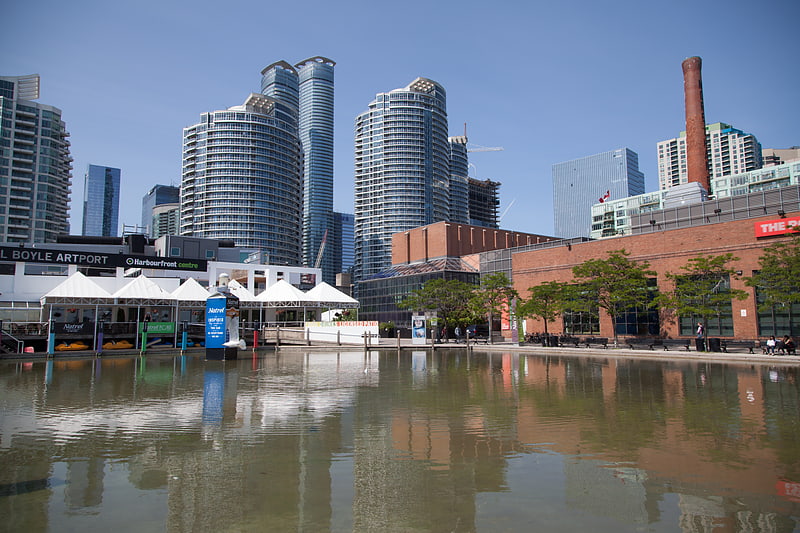
Non-profit organization. Harbourfront Centre is a key cultural organization on the waterfront of Toronto, Ontario, Canada, situated at 235 Queens Quay West. Established as a crown corporation in 1972 by the Government of Canada to create a waterfront park, it became a non-profit organization in 1991. Funding comes from corporate sponsors, government grants, individual donors and entrepreneurial activities. Harbourfront Centre has a seating capacity of 2,000.
Harbourfront Centre works with over 450 community organizations, and hosts more than 4,000 events a year in many disciplines such as theatre, dance, literature, music, film, visual arts and craft. The development is governed by a 26-person community based volunteer Board of Directors, and is assisted by approximately 2,000 volunteers who generously contribute their efforts and time. Harbourfront Centre is patrolled by its own in-house security team, which works closely with police to ensure that the property is protected.[3]
Address: 235 Queens Quay W, M5J 2G8 Toronto (Downtown Toronto)
Royal Ontario Museum
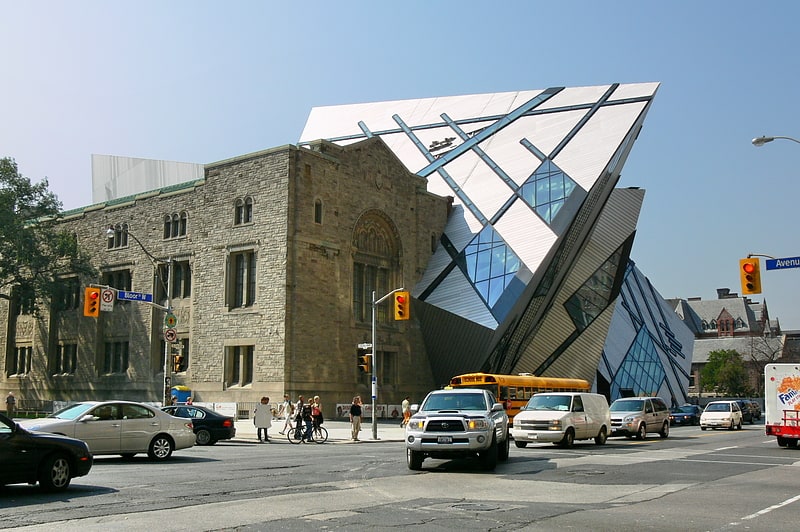
Huge range of culture and nature exhibits. The Royal Ontario Museum is a museum of art, world culture and natural history in Toronto, Ontario, Canada. It is one of the largest museums in North America and the largest in Canada. It attracts more than one million visitors every year, making the ROM the most-visited museum in Canada. The museum is north of Queen's Park, in the University of Toronto district, with its main entrance on Bloor Street West. Museum subway station is named after the ROM and, since a 2008 renovation, is decorated to resemble the institution's collection.
Established on 16 April 1912 and opened on 19 March 1914, the museum has maintained close relations with the University of Toronto throughout its history, often sharing expertise and resources. The museum was under the direct control and management of the University of Toronto until 1968, when it became an independent Crown agency of the Government of Ontario. Today, the museum is Canada's largest field-research institution, with research and conservation activities around the world.
With more than 6,000,000 items and 40 galleries, the museum's diverse collections of world culture and natural history contribute to its international reputation. The museum contains a collection of dinosaurs, minerals and meteorites; Canadian, and European historical artifacts; as well as African, Near Eastern, and East Asian art. It houses the world's largest collection of fossils from the Burgess Shale with more than 150,000 specimens. The museum also contains an extensive collection of design and fine art, including clothing, interior, and product design, especially Art Deco.[4]
Address: 100 Queens Park, M5S 2C6 Toronto (Downtown Toronto)
Hockey Hall of Fame
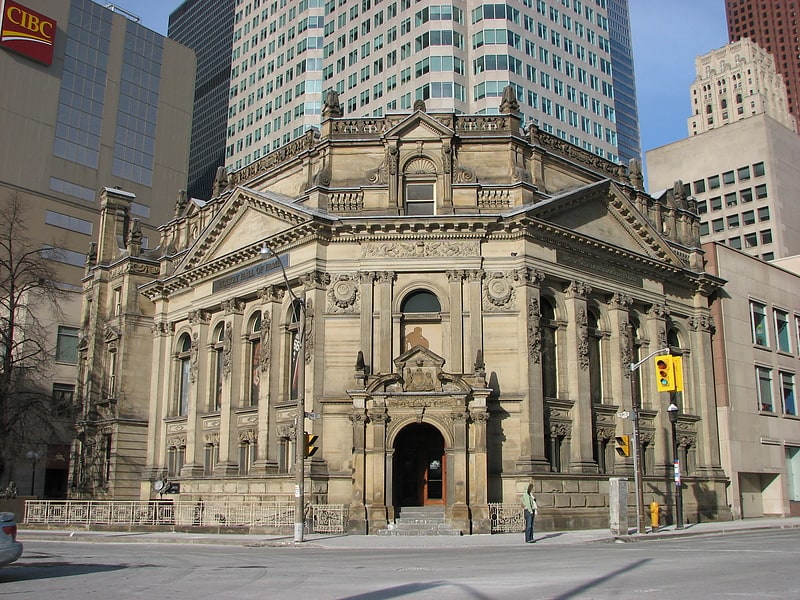
Museum in Toronto, Ontario. The Hockey Hall of Fame is a museum and hall of fame located in Toronto, Ontario, Canada. Dedicated to the history of ice hockey, it holds exhibits about players, teams, National Hockey League records, memorabilia and NHL trophies, including the Stanley Cup. Founded in Kingston, Ontario, the Hockey Hall of Fame was established in 1943 under the leadership of James T. Sutherland. The first class of honoured members was inducted in 1945, before the Hall of Fame had a permanent location. It moved to Toronto in 1958 after the NHL withdrew its support for the International Hockey Hall of Fame in Kingston, Ontario, due to funding issues. Its first permanent building opened at Exhibition Place in 1961. The hall was relocated in 1993, and is now in Downtown Toronto, inside Brookfield Place, and a historic Bank of Montreal building. The Hockey Hall of Fame has hosted International Ice Hockey Federation exhibits and the IIHF Hall of Fame since 1998.
An 18-person committee of players, coaches and others meets annually in June to select new honourees, who are inducted as players, builders or on-ice officials. In 2010, a subcategory was established for female players. The builders' category includes coaches, general managers, commentators, team owners and others who have helped build the game. Honoured members are inducted into the Hall of Fame in an annual ceremony held at the Hall of Fame building in November, which is followed by a special "Hockey Hall of Fame Game" between the Toronto Maple Leafs and a visiting team. As of 2020, 289 players (including eight women), 112 builders and 16 on-ice officials have been inducted into the Hall of Fame. The Hall of Fame has been criticized for focusing mainly on players from the National Hockey League and largely ignoring players from other North American and international leagues.[5]
Address: 30 Yonge St, M5E 1X8 Toronto (Downtown Toronto)
First Canadian Place
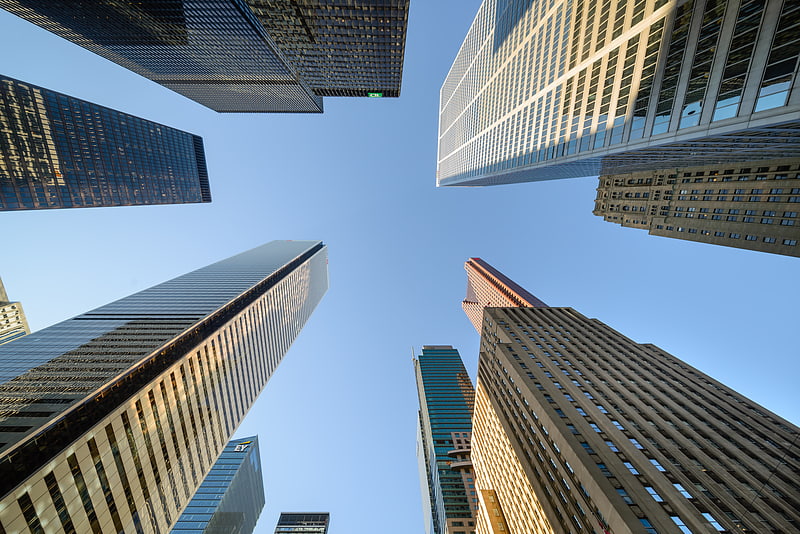
Skyscraper in Toronto, Ontario. First Canadian Place is a skyscraper in the Financial District of Toronto, Ontario, at the northwest corner of King and Bay streets, and serves as the global operational headquarters of the Bank of Montreal. At 298 m, it is Canada's tallest skyscraper and the 15th tallest building in North America to structural top and 9th highest to the roof top, and the 105th tallest in the world. It is the third tallest free-standing structure in Canada, after the CN Tower and the Inco Superstack chimney in Sudbury, Ontario. The building is owned by Manulife Financial Corporation in addition to a private consortium of investors including CPP Investments. The building is managed by Brookfield Office Properties.[6]
Address: 100 King St W, M5X 2A2 Toronto (Downtown Toronto)
Casa Loma

Stately castle with seasonal gardens. Casa Loma is a Gothic Revival style mansion and garden in midtown Toronto, Ontario, Canada, that is now a historic house museum and landmark. It was constructed from 1911 to 1914 as a residence for financier Sir Henry Pellatt. The architect was E. J. Lennox, who designed several other city landmarks. Casa Loma sits at an elevation of 140 metres above sea level, 66 metres above Lake Ontario.
Due to its unique architectural character in Toronto, Casa Loma has been a popular filming location for movies and television. It is also a popular venue for wedding ceremonies, and Casa Loma can be rented in the evenings after the museum closes to the public.[7]
Address: 1 Austin Terrace, M5R 1X8 Toronto (Midtown)
Ripley's Aquarium of Canada
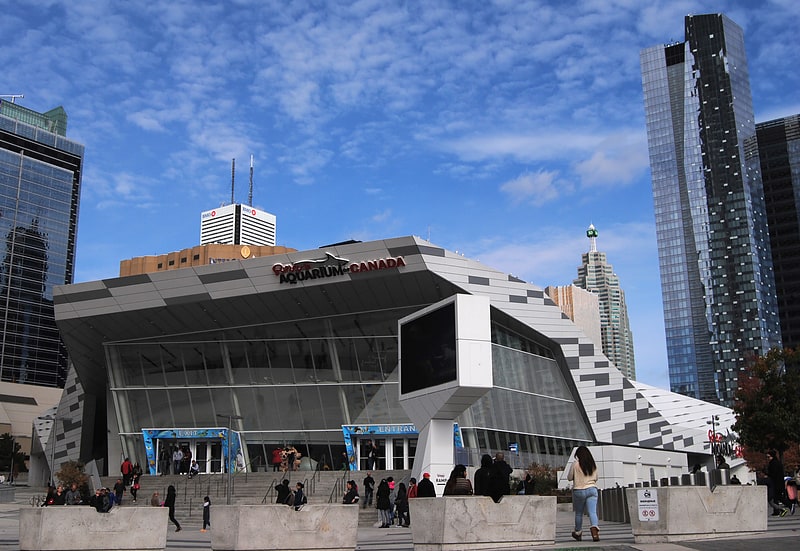
Aquarium in Toronto, Ontario. Ripley's Aquarium of Canada is a public aquarium in Toronto, Ontario, Canada. The aquarium is one of three aquariums owned-and-operated by Ripley Entertainment. It is located in downtown Toronto, just southeast of the CN Tower. The aquarium has 5.7 million litres of marine and freshwater habitats from across the world. The exhibits hold more than 20,000 exotic sea and freshwater specimens from more than 450 species.[8]
Address: 288 Bremner Blvd, M5V 3L9 Toronto (Downtown Toronto)
IIHF Hall of Fame

The IIHF Hall of Fame is a hall of fame operated by the International Ice Hockey Federation. It was founded in 1997, and has resided at the Hockey Hall of Fame in Toronto since 1998. Prior to 1997, the IIHF housed exhibits at the International Hockey Hall of Fame in Kingston, Ontario. Inductions are made annually at the medal presentation day of the Ice Hockey World Championships. As of 2021, the IIHF has inducted 237 members.[9]
Woodbine Centre
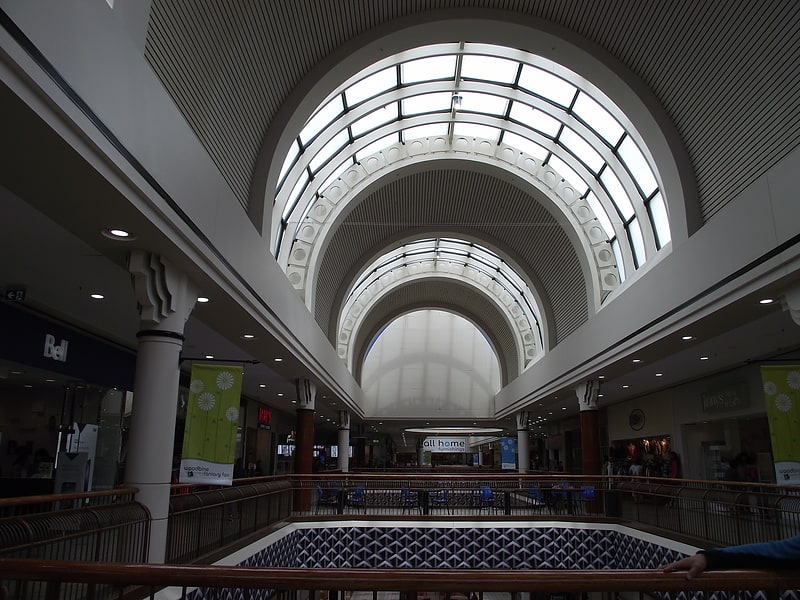
Shopping mall in Toronto, Ontario. Woodbine Centre is a shopping mall in the Rexdale area of Toronto, Ontario, Canada. It is located across Rexdale Boulevard from Woodbine Racetrack in the former city of Etobicoke.
Opened in 1985 by developer Cadillac Fairview, the over 130 store mall is home to Fantasy Fair, a year-round indoor amusement park. The fair houses a Charles I. D. Looff carousel. It is one of 13 still in operation today. They also have a 50-foot ferris wheel which they say is the only one in North America.
Its design served as inspiration for property developer Sir John Hall when planning the MetroCentre, the UK's largest shopping mall, in the 1980s.[10]
Address: 500 Rexdale Blvd, M9W 6K5 Toronto (Rexdale)
The Power Plant
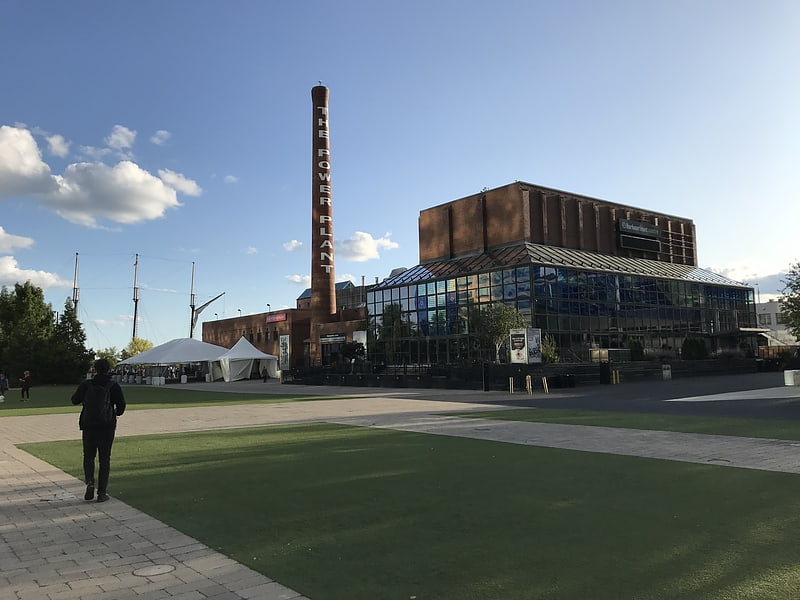
Art gallery in Toronto, Ontario. The Power Plant Contemporary Art Gallery is a Canadian non-collecting public gallery devoted to contemporary art, located in Toronto, Ontario at Harbourfront Centre. It is a registered Canadian charitable organization supported by its members, sponsors, donors, and funding bodies at all levels of government.
Initially established as the Art Gallery at Harbourfront in 1976, the Power Plant was officially opened in 1987 in its current location. It has presented new and recent work by living Canadian and international artists, mounting major solo shows and thematic exhibitions by artists such as AA Bronson, John Akomfrah, Terry Adkins, Carlos Amorales, Yto Barrada, Patrick Bernatchez, Christian Boltansky, Janet Cardiff, Peter Doig, Latifa Echakhch, Geoffrey Farmer, Jack Goldstein, Ann Hamilton, Leslie Hewitt, Thomas Hirschhorn, Zhang Huan, Maria Hupfield, Mike Kelley, Shelagh Keeley, Micah Lexier, Duane Linklater, Liz Magor, Christian Marclay, Kelly Mark, Emily Mast, Steve McQueen, Kent Monkman, Mike Nelson, Adrian Piper, Ed Poitras, Annie Pootoogook, Pedro Cabrita Reis, Pedro Reyes, Michael Snow, Jana Sterback, Derek Sullivan, Superflex, Ryan Trecartin, Ian Wallace, Franz Erhard Walther, Lawrence Weiner, Akram Zaatari, Zineb Sedira, Amalia Pica, Vivian Suter, Shuvinai Ashoona, Omar Ba, Alicia Henry, Joana Hadjithomas and Joreige Khalil, Rashid Johnson, Naeem Mohaiemen, Vincent Meessen, Hajra Waheed, among others.
The gallery hosts educational programs and events for the public, and produces artist books, editions and publications for research and dissemination. It has published more than forty works.[11]
Address: 231 Queens Quay W, M5J 2G8 Toronto (Downtown Toronto)
St. Lawrence Market

Market in Toronto, Ontario. The St. Lawrence Market South building is a major public market building in Toronto, Ontario, Canada. It is located on the southwest corner of Front and Lower Jarvis Streets. Along with the St. Lawrence Market North and St. Lawrence Hall, it comprises the St. Lawrence Market complex. The current building was opened in 1902, incorporating the 1845 Toronto City Hall building into the structure. The building was restored during the 1970s.[12]
Address: Toronto, 92 Front Street East
Toronto Zoo

Sprawling home of thousands of animals. The Toronto Zoo is a zoo located in Toronto, Ontario, Canada. Encompassing 287 hectares, the Toronto Zoo is the largest zoo in Canada. It is divided into seven zoogeographic regions: Indo-Malaya, Africa, Americas, Tundra Trek, Australasia, Eurasia, and the Canadian Domain. Some animals are displayed indoors in pavilions and outdoors in what would be their naturalistic environments, with viewing at many levels. It also has areas such as the Kids Zoo, Waterside Theatre, and Splash Island. It has one of the most taxonomically diverse collection of animals on display of any zoo; it is currently home to over 5,000 animals representing over 500 species. The zoo is open to the public every day of the year except December 25.
The zoo is a corporation owned by the municipal government of Toronto. Founded by John Cameron Egan and business partner, Hugh A. Crothers, an industrialist who became the first Chairman of the Metro Toronto Zoological Society in 1966, the zoo opened on August 15, 1974, as the Metropolitan Toronto Zoo. The word "Metropolitan" was dropped from its name when the individual municipalities that make up the Municipality of Metropolitan Toronto was amalgamated into the current city in 1998. The zoo is located near the Rouge River on the western border of Rouge Park in the city's east end district of Scarborough.[13]
Woodbine Racetrack

Racecourse in Toronto, Ontario. Woodbine Racetrack is a race track for Thoroughbred horse racing in the Etobicoke area of Toronto, Ontario, Canada. Owned by Woodbine Entertainment Group, Woodbine Racetrack manages and hosts Canada's most famous race, the Queen's Plate. The track was opened in 1956 with a one-mile oval dirt track, as well as a seven-eights turf course. It has been extensively remodeled since 1993, and since 1994 has had three racecourses.[14]
Address: 555 Rexdale Blvd., M5W 3H5 Toronto (Rexdale)
Roundhouse Park
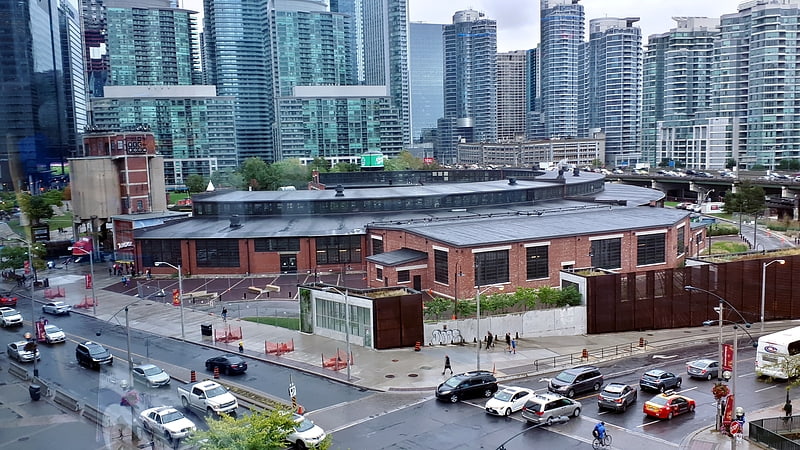
Museum in Toronto, Ontario. Roundhouse Park is a 17 acre park in the downtown core of Toronto, Ontario, Canada. It is in the former Railway Lands. It features the John Street Roundhouse, a preserved locomotive roundhouse which is home to the Toronto Railway Museum, Steam Whistle Brewing, and the restaurant and entertainment complex The Rec Room. The park is also home to a collection of trains, the former Canadian Pacific Railway Don Station, and the Roundhouse Park Miniature Railway. The park is bounded by Bremner Boulevard, Lower Simcoe Street, Lake Shore Boulevard West/Gardiner Expressway and Rees Street.[15]
Old City Hall
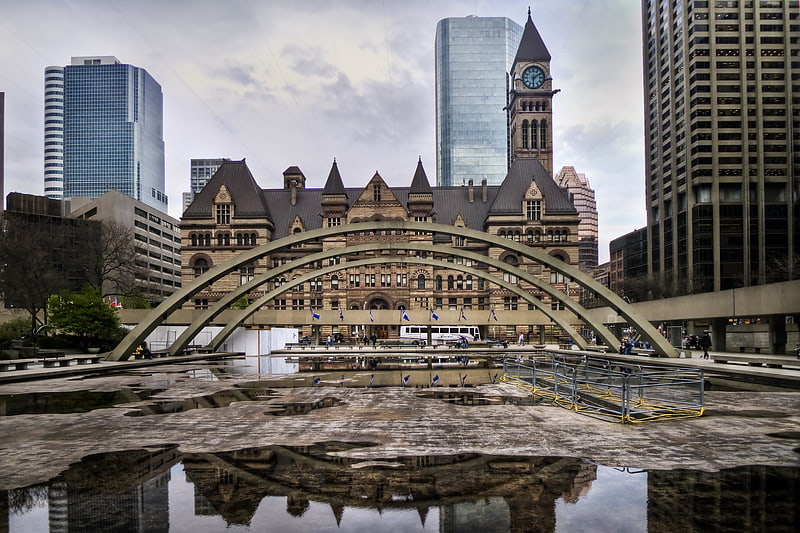
Romanesque landmark with a clock tower. The Old City Hall is a Romanesque-style civic building and court house in Toronto, Ontario, Canada. It was the home of the Toronto City Council from 1899 to 1966 and remains one of the city's most prominent structures.
The building is located at the corner of Queen and Bay Streets, across Bay Street from Nathan Phillips Square and the present City Hall in Downtown Toronto. The heritage landmark has a distinctive clock tower which heads the length of Bay Street from Front Street to Queen Street as a terminating vista. Old City Hall was designated a National Historic Site in 1984.[16]
Address: Toronto, 60 Queen Street West
Allan Gardens
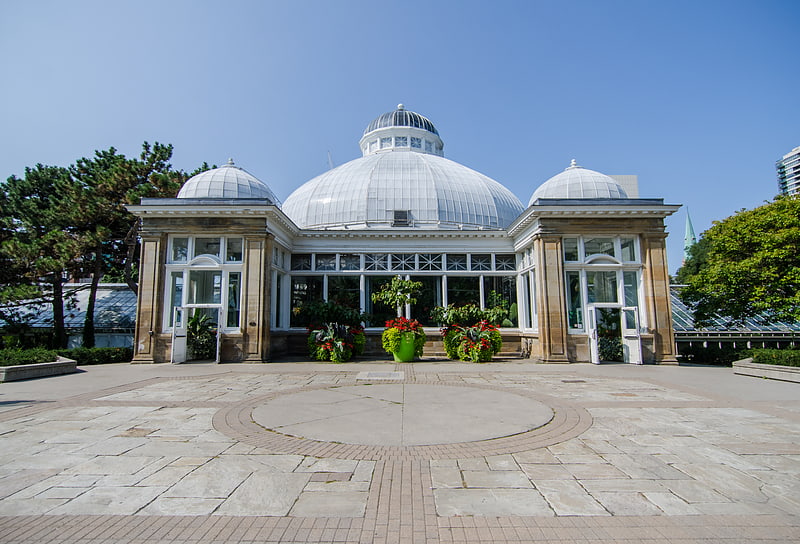
Exotic plants in a historic building. Allan Gardens is a conservatory and urban park located in the Garden District of Toronto, Ontario, Canada. The property includes a playground, off-leash dog park, and a 1,500 square metres conservatory with six green houses.
The park originated from lands donated to the Toronto Horticultural Society by George William Allan in 1858, with the horticultural society officially opening a gardens there in 1860. In 1864, the municipal government of Toronto acquired the lands surrounding the gardens, although allowed the horticultural society to maintain it in return for permitting its public use. The conservatory was later acquired by the municipal government in 1888. The park and the gardens was initially known as the Horticultural Gardens until 1901, when it was renamed after Allan. A fire ravaged and destroyed a three-storey pavilion at the park in 1902. However, a new conservatory building, the Palm House was later completed on the property in 1910. The park has become a popular gathering place for protest since the mid-20th century.[17]
Address: 19 Horticultural Ave, M5A 2P2 Toronto (Downtown Toronto)
Maple Leaf Gardens
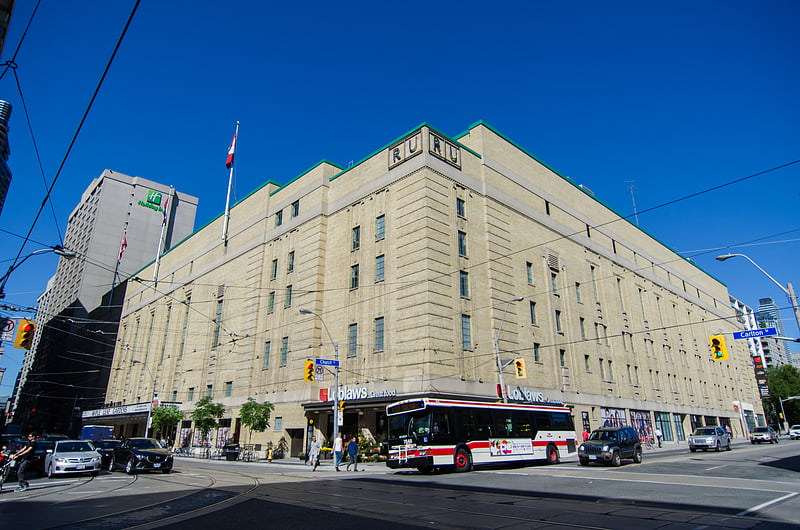
Arena in Toronto, Ontario. Maple Leaf Gardens is a historic building located at the northwest corner of Carlton Street and Church Street in Toronto, Ontario, Canada. The building was initially constructed in 1931 as an arena to host ice hockey games, though it has since been reconstructed for other uses.
Today, Maple Leaf Gardens is a multi-purpose facility, with Loblaws occupying retail space on the lower floors and an arena for Toronto's Ryerson University, known as Mattamy Athletic Centre at the Gardens, occupying the top level.
Considered one of the "cathedrals" of hockey, it was home to the Toronto Maple Leafs of the National Hockey League from 1931 to 1999. The Leafs won the Stanley Cup 11 times from 1932 to 1967 while playing at the Gardens. The first NHL All-Star Game, albeit an unofficial one, was held at the Gardens in 1934 as a benefit for Leafs forward Ace Bailey, who had suffered a career-ending head injury. The first official annual National Hockey League All-Star Game was also held at Maple Leaf Gardens in 1947.
It was home to the Toronto Huskies (1946–1947) in their single season in the Basketball Association of America (a forerunner of the National Basketball Association), the Toronto Marlboros of the Ontario Hockey League, the Toronto Toros of the World Hockey Association (1974–1976), the Toronto Blizzard of the North American Soccer League (1980–1982 indoor seasons), the Toronto Shooting Stars of the National Professional Soccer League (1996–1997), and the Toronto Rock of the National Lacrosse League (1999–2000). The NBA's Buffalo Braves played a total of 16 regular season games at Maple Leaf Gardens from 1971 to 1975. The NBA's Toronto Raptors played six games at the Gardens from 1997 to 1999, mostly when SkyDome was unavailable.
It was also one of the few venues outside the United States where Elvis Presley performed in concert (April 2, 1957). In 1972, Maple Leaf Gardens hosted game 2 of the famous Summit Series between Team Canada and the USSR. Team Canada won the game 4–1.[18]
Address: Toronto, 60 Carlton Street
High Park

Urban green space with trails and a zoo. High Park is a municipal park in Toronto, Ontario, Canada. High Park is a mixed recreational and natural park, with sporting facilities, cultural facilities, educational facilities, gardens, playgrounds and a zoo. One-third of the park remains in a natural state, with a rare oak savannah ecology. High Park was opened to the public in 1876 and is based on a bequest of land from John George Howard to the City of Toronto. It spans 161 hectares and is the second-largest municipal park in Toronto, after Centennial Park.
High Park is located to the west of downtown Toronto, north of Humber Bay, and is maintained by the City of Toronto Parks Department. It stretches south from Bloor Street West to The Queensway, just north of Lake Ontario. It is bounded on the west by Ellis Park Road and Grenadier Pond and on the east by Parkside Drive.[19]
Address: 1873 Bloor St. W, M6R 2Z3 Toronto (West End)
Toronto Islands
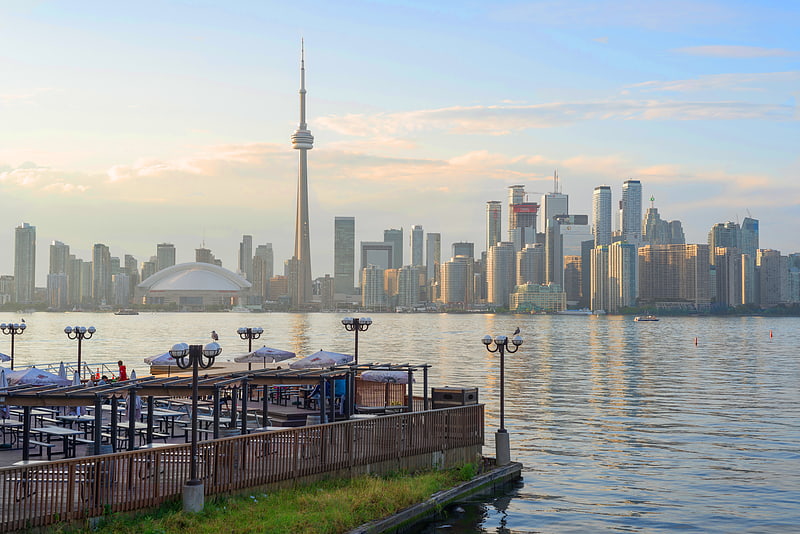
Offshore spot with beaches and recreation. The Toronto Islands —are a chain of 15 small islands in Lake Ontario, south of mainland Toronto, Ontario, Canada.
Comprising the only group of islands in the western part of Lake Ontario, the Toronto Islands are located just offshore from the city's downtown area, provide shelter for Toronto Harbour, and separate Toronto from the rest of Lake Ontario. The islands are home to the Toronto Island Park, the Billy Bishop Toronto City Airport, several private yacht clubs, a public marina, Centreville Amusement Park, a year round residential neighbourhood, and several public beaches. The island community is the largest urban car-free community in North America. All access to the Islands is by water, by City of Toronto ferries operating all year from Jack Layton Ferry Terminal at the foot of Bay Street or privately operated water taxis during the months of May to September.
The Toronto Islands are a popular tourist and recreational destination. Bicycles are accommodated on the ferries at no charge and can be rented at Centre Island. Canoes, kayaks, paddle boats and stand up paddle boards are also available for rental from May to September. A disc golf course exists on the island. The main beach is along the south shore of Centre Island and part of the beach on the west shore of Centre at Hanlans Point is clothing-optional. There is ample parkland suitable for picnicking, several playgrounds, water play areas and several gardens. During the winter months people access the lagoons and Toronto Harbour from the islands for ice skating when conditions permit.[20]
BAPS Shri Swaminarayan Mandir Toronto
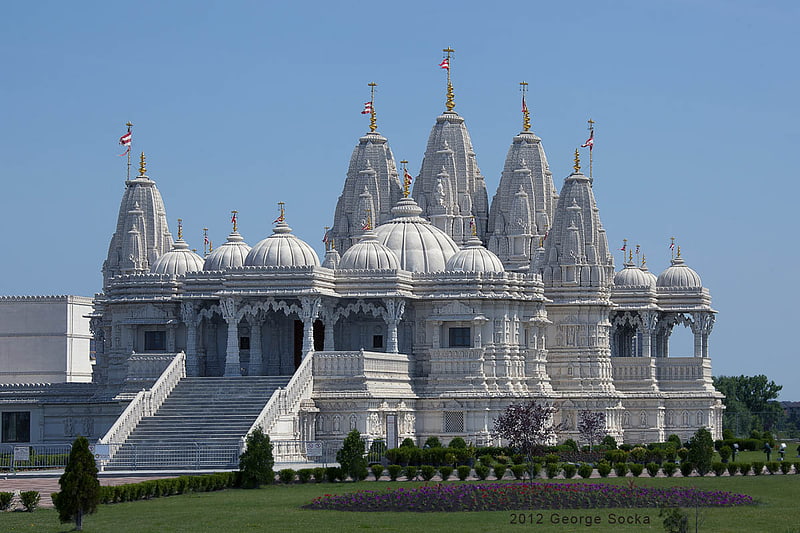
Hindu temple in Toronto, Ontario. The BAPS Shri Swaminarayan Mandir in Etobicoke, Toronto, Ontario, Canada is a traditional Hindu place of worship that was built by the BAPS Swaminarayan Sanstha. The BAPS Swaminarayan Sanstha, which is headed by Mahant Swami Maharaj, is a global spiritual organization within the Swaminarayan branch of Hinduism. The mandir was built in 18 months and consists of 24,000 pieces of hand-carved Italian carrara marble, Turkish limestone and Indian pink stone. The mandir is the largest of its kind in Canada and was constructed according to guidelines outlined in ancient Hindu scriptures. The grounds spread over 18 acres and in addition to the mandir, include a haveli and the Heritage Museum. The mandir is open daily to visitors and for worship. In July 2017, the temple celebrated its 10-year anniversary.[21]
Address: 61 Claireville Dr, M9W 5Z7 Toronto (Rexdale)
Martin Goodman Trail
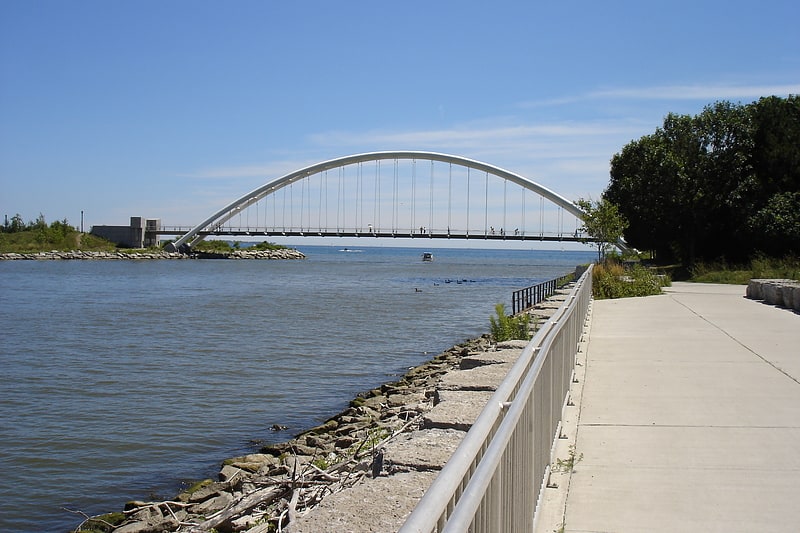
The Martin Goodman Trail is a 56-kilometre multi-use path along the waterfront in Toronto, Ontario, Canada. It traverses the entire lake shore from one end of the city to the other, from Humber Bay Arch Bridge in the west to the Rouge River in the east. The Martin Goodman Trail is part of the 730 km Waterfront Trail around Lake Ontario.[22]
Address: Lakeshore blvd, Toronto (West End)
Yonge-Dundas Square
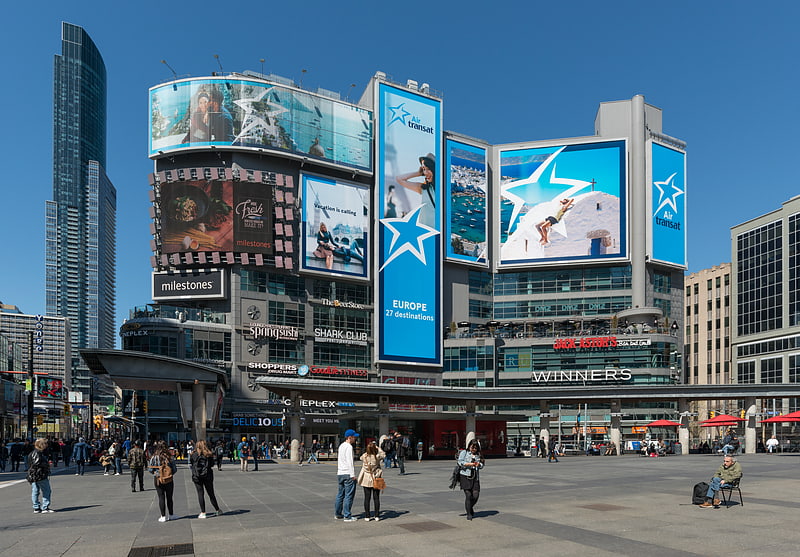
Outdoor hub for live entertainment. Yonge–Dundas Square, or Dundas Square, is a public square at the southeast corner of the intersection of Yonge Street and Dundas Street East in Downtown Toronto, Ontario, Canada. Designed by Brown and Storey Architects, the square was conceived in 1997 as part of revitalizing the intersection. Since its completion in 2002, the square has hosted many public events, performances and art displays, establishing itself as a prominent landmark in Toronto and one of the city's prime tourist attractions. Central to the Downtown Yonge entertainment and shopping district, the square is owned by the city and is the first public square in Canada to be maintained through a public-private partnership. The intersection is one of the busiest in Canada, with over 100,000 people crossing the city's first pedestrian scramble daily.
Surrounding the square are other major landmarks, including the Toronto Eaton Centre, Ed Mirvish Theatre, and the Citytv building. The square is accessible by the Toronto subway at Dundas station and is connected to the PATH. The square is continuously illuminated by large billboard screens and corporate logos, which has led to comparison of the square with Times Square in New York City and Piccadilly Circus in London.[23]
Address: 40 Dundas Street West, Suite 227, Toronto (Downtown Toronto)
City Hall
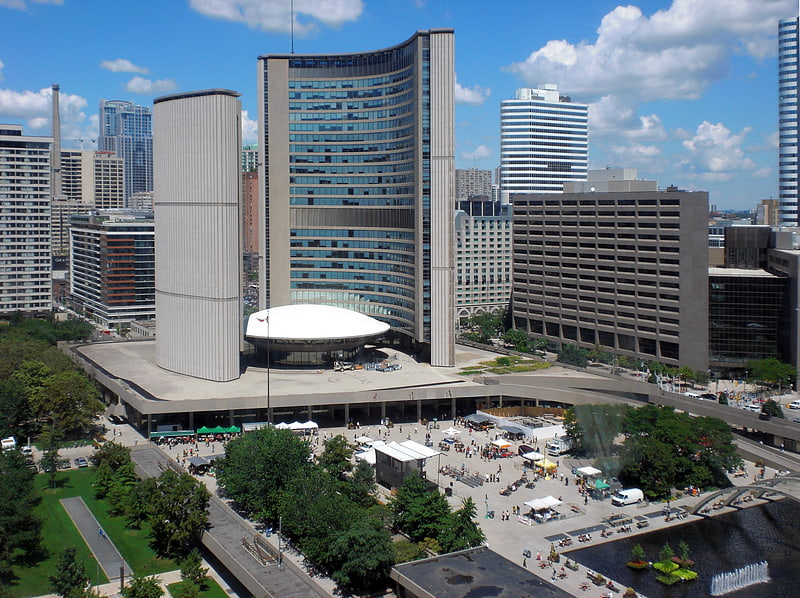
Landmark complex and office of the mayor. The Toronto City Hall, or New City Hall, is the seat of the municipal government of Toronto, Ontario, Canada, and one of the city's most distinctive landmarks. Designed by Viljo Revell and engineered by Hannskarl Bandel, the building opened in 1965. It replaced the neighbouring Old City Hall, which was occupied by the municipal government since 1899 and continues to house municipal offices and courts. The new city hall is located adjacent to Nathan Phillips Square at the northwest intersection of Bay Street and Queen Street.[24]
Address: Toronto, 100 Queen Street West
Stone Distillery
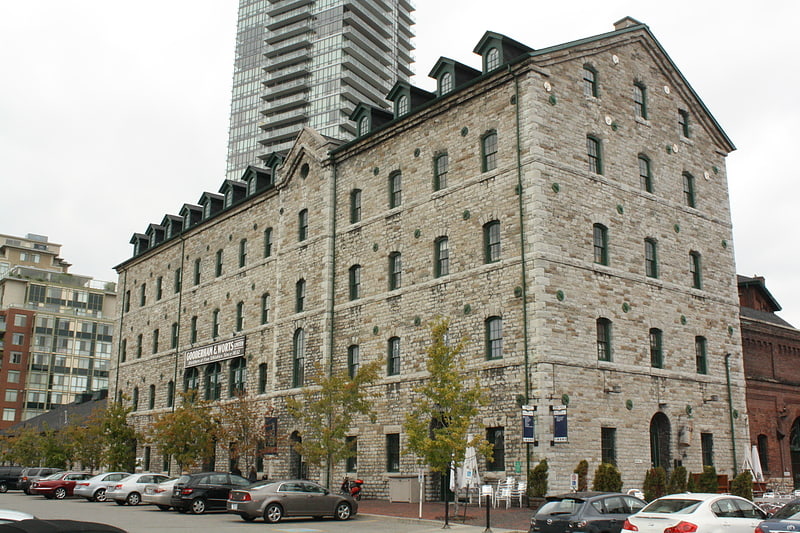
Heritage building in Toronto, Ontario. The Stone Distillery is an 1859 heritage industrial building in Toronto, Ontario, Canada. It is the oldest and largest building in the Distillery District complex of Gooderham & Worts Distillery buildings.[25]
OCAD University

College in Toronto, Ontario. Ontario College of Art & Design University, commonly known as OCAD University, is a public university of art and design located in Toronto, Ontario, Canada. The main campus is adjacent to the Art Gallery of Ontario, within the Grange Park neighbourhood. The school is Canada's largest and oldest educational institution for art and design. OCAD U offers courses through the Faculties of Art, Design, Liberal Arts and Sciences, and alternative programs. The enabling legislation is the Ontario College of Art and Design University Act, 2002.[26]
Address: 100 McCaul St, M5T 1W1 Toronto (Downtown Toronto)
Lamport Stadium
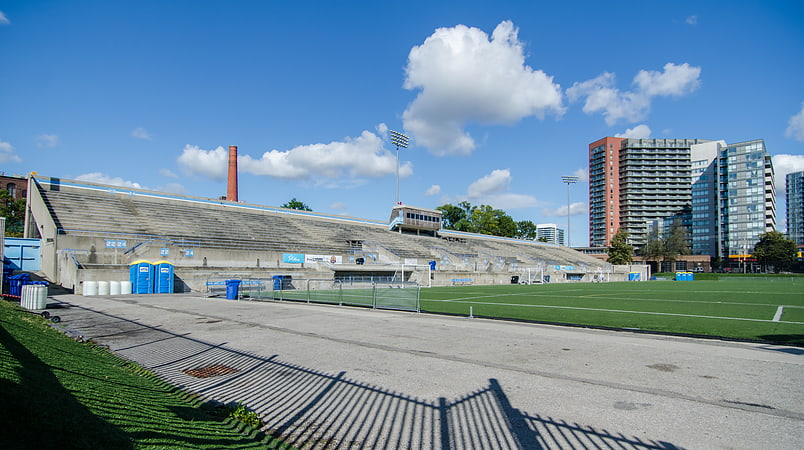
Multi-purpose stadium in Toronto, Ontario. Allan A. Lamport Stadium is a multi-purpose stadium on King Street West in the Liberty Village neighbourhood of Toronto, Ontario, Canada. It is the practice facility for the Toronto Argonauts of the Canadian Football League. It is also partial home for Canada national rugby league team. The playing surface of the 9,600 seating capacity stadium is also dually marked for soccer and field hockey. The stadium was named for long-time Toronto politician Allan Lamport, who was associated with sporting activities in the city.[27]
Address: 1151 King St W, M6K 1E9 Toronto (West End)
Toronto-Dominion Centre
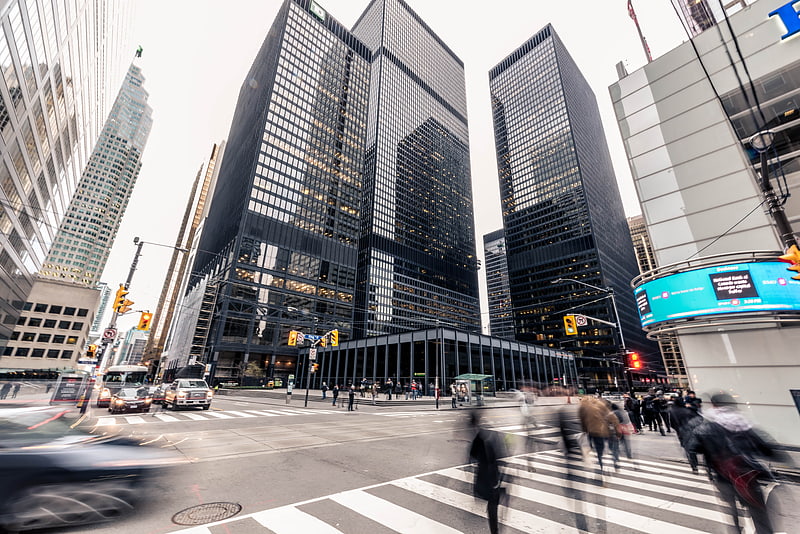
Building complex in Toronto, Ontario. The Toronto-Dominion Centre, or TD Centre, is an office complex in the Financial District of downtown Toronto owned by Cadillac Fairview. It serves as the global headquarters for its anchor tenant, the Toronto-Dominion Bank, and provides office and retail space for many other businesses. The complex consists of six towers and a pavilion covered in bronze-tinted glass and black painted steel. Approximately 21,000 people work in the complex, making it the largest commercial office complex in Canada.
The project was the inspiration of Allen Lambert, former President and Chairman of the Board of the Toronto-Dominion Bank. Sister-in-law Phyllis Lambert recommended Ludwig Mies van der Rohe as design consultant to the architects, John B. Parkin and Associates and Bregman + Hamann, and the Fairview Corporation as the developer. The towers were completed between 1967 and 1991. An additional building was built outside the campus and purchased in 1998. As Mies was given "virtually a free hand to create Toronto-Dominion Centre", the complex, as a whole and in its details, is a classic example of his unique take on the International style and represents the end evolution of Mies's North American period.[28]
Address: King St. W and Wellington St W, Toronto (Downtown Toronto)
Spadina House
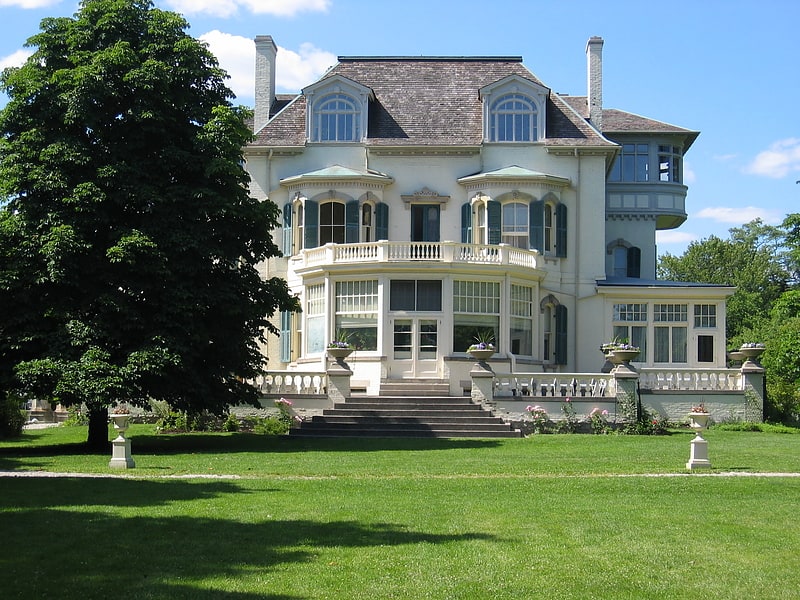
Local domestic life in the 1920s and '30s. Spadina Museum: Historic House & Gardens, also known as Spadina House, is a historic mansion at 285 Spadina Road in Toronto, Ontario, Canada, that is now a historic house museum operated by the City of Toronto's Economic Development & Culture division. The museum preserves the house much as it existed and developed historically. The art, decor and architecture of the house used to reflect the contemporary styles of the 1860s through the 1930s, including Victorian, Edwardian, Arts and Crafts, Art Deco, Art Nouveau and Colonial Revival styles. The museum closed for a year for extensive interior and exterior renovations. When it re-opened to the public on October 24, 2010, it was decorated in the style of the inter-war era of the 1920s and 1930s. The estate's gardens reflect the landscape during the Austin family's occupation of the house.[29]
Address: 285 Spadina Rd, M5R 2V5 Toronto (Midtown)
Ontario Science Centre
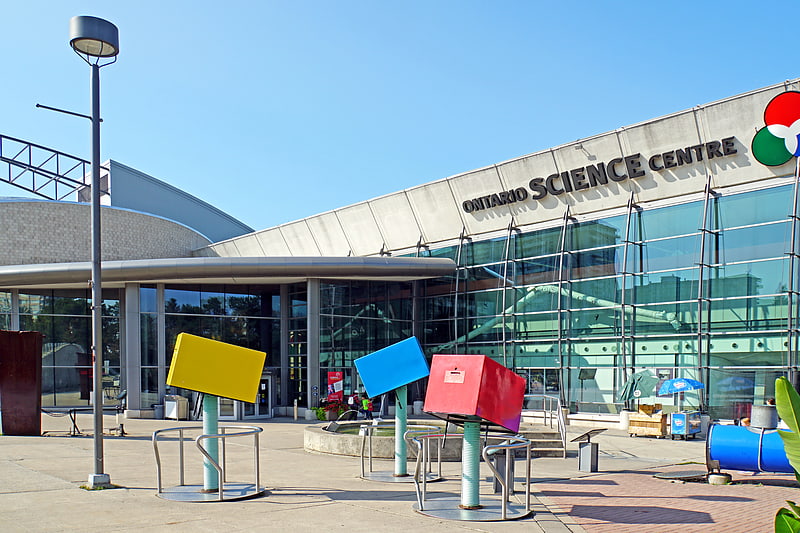
Hands-on exhibits at kid-friendly museum. The Ontario Science Centre, formally the Centennial Museum of Science and Technology, is a science museum in Toronto, Ontario, Canada, near the Don Valley Parkway about 11 kilometres northeast of downtown on Don Mills Road just south of Eglinton Avenue East in the former city of North York. It is built down the side of a wooded ravine formed by one branch of the Don River located in Flemingdon Park.[30]
Address: 770 Don Mills Rd, M3C 1T3 North York (North York)
Nathan Phillips Square
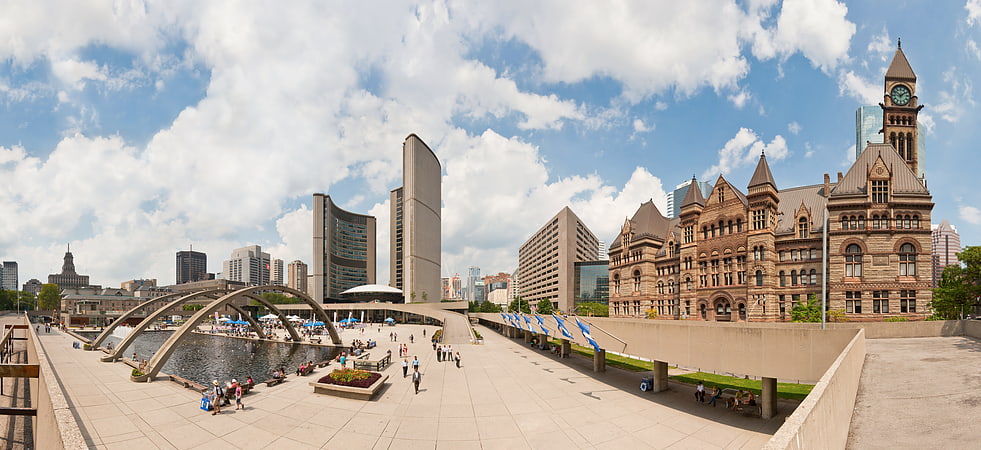
Public gathering place with winter rink. Nathan Phillips Square is an urban plaza in Toronto, Ontario, Canada. It forms the forecourt to Toronto City Hall, or New City Hall, at the intersection of Queen Street West and Bay Street, and is named for Nathan Phillips, mayor of Toronto from 1955 to 1962. The square was designed by the City Hall's architect Viljo Revell and landscape architect Richard Strong. It opened in 1965. The square is the site of concerts, art displays, a weekly farmers' market, the winter festival of lights, and other public events, including demonstrations. During the winter months, the reflecting pool is converted into an ice rink for ice skating. The square attracts an estimated 1.5 million visitors yearly. With an area of 4.85 hectares, it is Canada's largest city square.
Nathan Phillips Square is used regularly for art exhibits, concerts, rallies and other ceremonies. Annual events include a New Year's Eve Party and the Cavalcade of Lights Festival lighting of the official Christmas tree. The annual Nuit Blanche art festival sets up art exhibits in the Square, and has also utilized the parking garage located underneath the square.[31]
Address: 100 Queen St W, M5H 2N1 Toronto (Downtown Toronto)
Philosopher's Walk
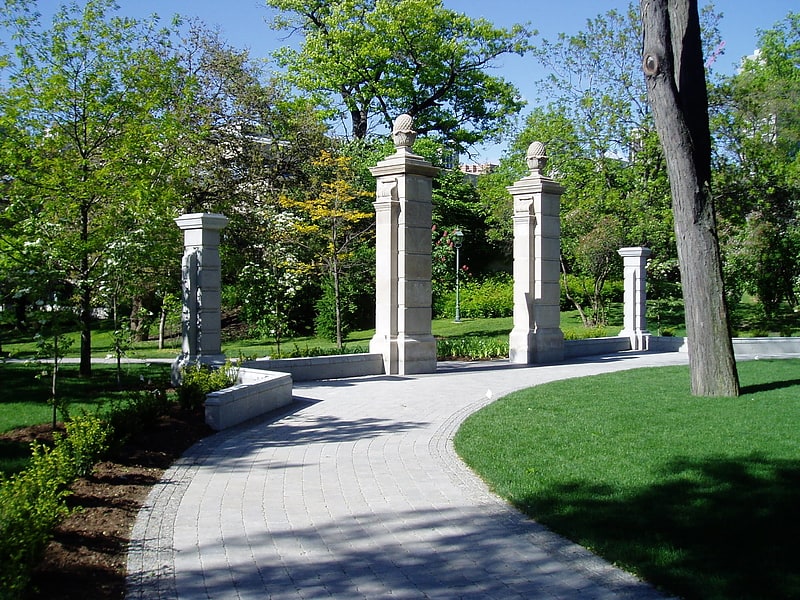
Park in Toronto, Ontario. Philosopher's Walk is a scenic footpath located in the St George campus of the University of Toronto in Toronto, Ontario. It runs in the north–south direction along the ravine landscape created by Taddle Creek, once a natural waterway that was buried during the Industrial Age and is now flowing underground. The path is bounded by several Toronto landmarks, including the Royal Ontario Museum, the Royal Conservatory of Music, Trinity College, the University of Toronto Faculty of Music, and the University of Toronto Faculty of Law.
Philosopher's Walk links the heart of the university campus to the northern edge bounding The Annex, an academic neighborhood where many of the university's faculty and student body reside. Philosopher Ted Honderich described the walk from his experience as a student
was in the middle of the city and had good Victorian buildings, and also such necessary pieces of tradition as a Philosopher's Walk, which led out towards an old village enclosed by the growth of Toronto. The village had not yet been smartened up, and only those academics so supremely rational as to want to walk to work lived in it.
The Alexandra Gates at the northern entrance to the path were constructed at the corner of Bloor Street and Avenue Road in 1901, at the instigation of the Imperial Order of the Daughters of the Empire, and to commemorate the visit of Prince George, Duke of Cornwall (later King George V), and Mary, Duchess of Cornwall (later Queen Mary), that year. The letters on each post — E and A — stand for Edward and Alexandra, the reigning King and Queen at the time. When Avenue Road was widened in 1960, the gates were moved to the head of Philosopher's Walk. In recognition of the royal visit, a plaque at the site reads "To commemorate the visit of T.R.H The Duke and Duchess of Cornwall and York Oct. 10th 1901".
The small amphitheater on the walk was built around 2010.[32]
Law Society of Ontario Archives

The Law Society of Ontario Archives collects and preserves records and other material that documents the history of the legal profession in Ontario. The Archives acquires and preserves records of permanent value to the Law Society of Ontario, the regulatory body for lawyers and paralegals in the province of Ontario. The Archives also accepts external donations of material that is significant to the legal profession in Ontario. The Archives serves as an information resource centre for Law Society staff, the legal profession, and the public.[33]
Design Exchange
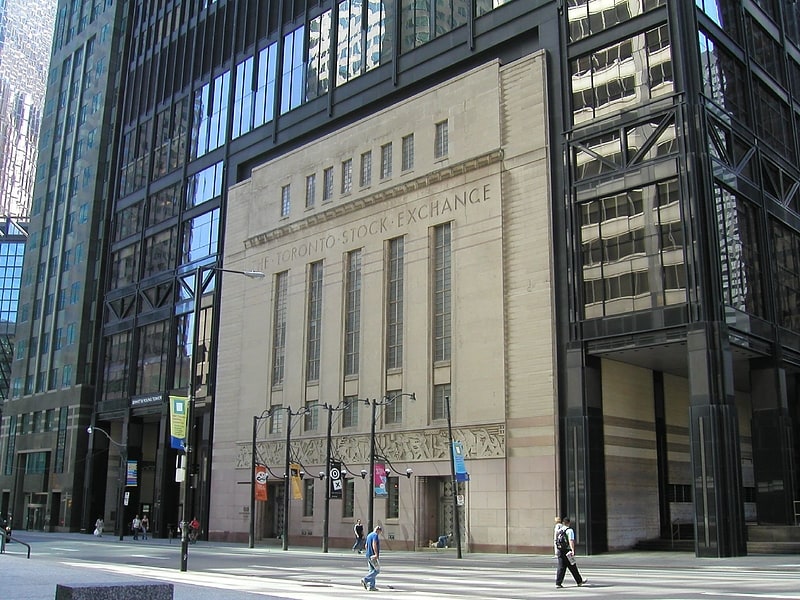
Museum in Toronto, Ontario. The Design Exchange is a Canadian not-for-profit cultural organization with the goal of promoting design, creativity and innovation. It is located in Toronto's financial district in the historical Toronto Stock Exchange building, that was incorporated into a skyscraper in 1991, the Toronto-Dominion Centre. The organisation operated a design museum, but this museum was closed in 2019. Since 2017, it hosts a biennial design festival, the Expo for Design, Innovation & Technology.[34]
Address: 234 Bay St, M5K 1B2 Toronto (Downtown Toronto)
St. Michael's Cathedral Basilica
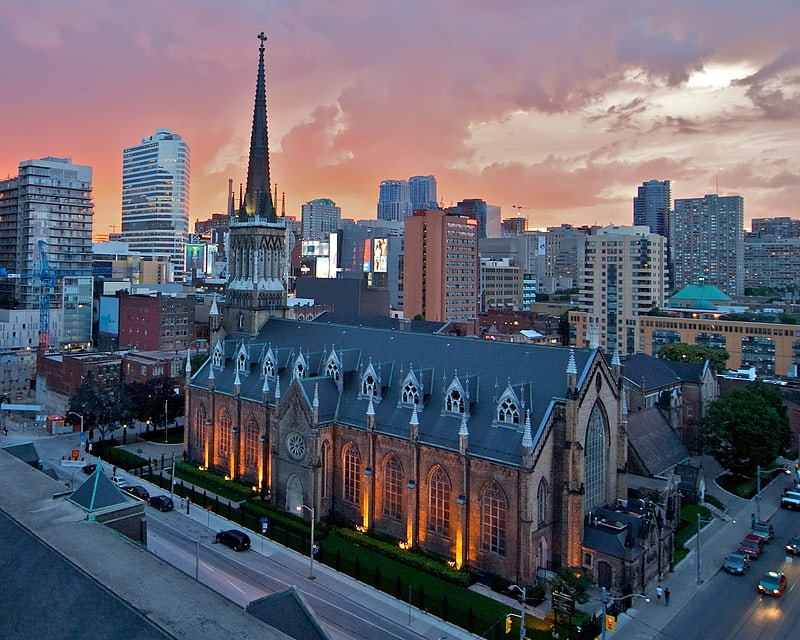
Cathedral in Toronto, Ontario. St. Michael's Cathedral Basilica is the cathedral church of the Roman Catholic Archdiocese of Toronto, Canada, and one of the oldest churches in Toronto. It is located at 65 Bond Street in Toronto's Garden District. St. Michael's was designed by William Thomas, designer of eight other churches in the city, and was primarily financed by Irish immigrants who resided in the area. The cathedral has a capacity of 1600. John Cochrane and Brothers undertook the work on the stone and stucco ornamentation of the interior.
St. Michael's Cathedral is a major building of faith in downtown Toronto. It was originally constructed away from the city's centre, but over time the city has grown to encompass it. It was constructed to better serve the growing Roman Catholic population of Toronto. It is a prime example of the English Gothic Revival style of architecture. On September 29, 2016, the feast day of Saint Michael the Archangel, the cathedral was elevated to a minor basilica.[35]
Address: 65 Bond St, M5B 1X1 Toronto (Downtown Toronto)